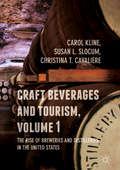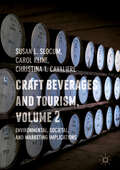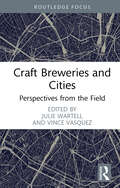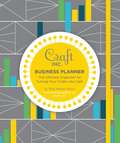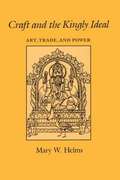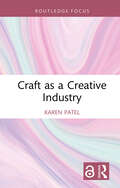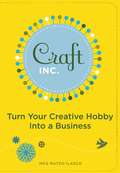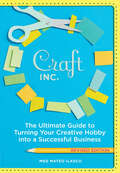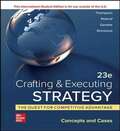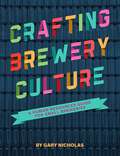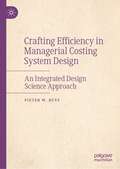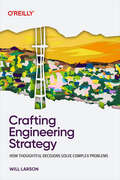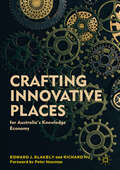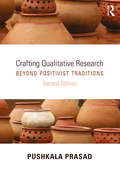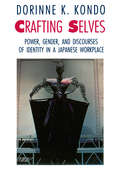- Table View
- List View
Craft Beverages and Tourism, Volume 1: The Rise of Breweries and Distilleries in the United States
by Carol Kline Susan L. Slocum Christina T. CavaliereThis two-volume set examines the strong connection between craft beverages and tourism, presenting cutting-edge research in partnership with breweries, distilleries, and cideries. While wine, food, and culinary tourism have traditionally dominated destination markets, interest in craft beverages has gained momentum across the US and overseas with local markets quickly recognizing the growing craft beverage movement. Through the eyes of tourism scholars, brewers, and travelers, these two volumes explore the landscape of craft beer opportunities in non-traditional settings, and recognize the potential for future economic, socio-cultural, and environmental sustainability. Craft Beverages and Tourism, Volume 1: The Rise of Breweries and Distilleries in the United States is an inclusive and overarching examination of the US craft beverage phenomenon within a larger context of international beverage tourism. It outlines the current practice and research scope of craft beer, cider, and spirits as well as the sustainable development of destinations revolving around craft beverage. Through literature reviews, case studies, and general exploration, this volume advances marketing, hospitality, and leisure studies research for academics, industry experts, and emerging entrepreneurs.
Craft Beverages and Tourism, Volume 2: Environmental, Societal, and Marketing Implications
by Carol Kline Susan L. Slocum Christina T. CavaliereThis volume applies a mix of qualitative and quantitative research and case studies to analyze the role that the craft beverage industry plays within society at large. It targets important themes such as environmental conservation and social responsibility, as well as the psychology of the craft beer drinker and their impact on tourism marketing. This volume advances marketing, hospitality, and leisure studies research for academics, industry experts, and emerging entrepreneurs.
Craft Breweries and Cities: Perspectives from the Field (Routledge Critical Beverage Studies)
by Julie Wartell Vince VasquezThis book brings together a diverse collection of case studies, perspectives, and research to explore how craft breweries have interacted with cities and neighborhoods in meaningful ways. It provides a deeper understanding of the important issues facing neighborhoods, city government, and breweries, such as economic development, race and equity, crime, and sustainability. It demonstrates how craft breweries are meaningful contributors and participants in addressing these critical challenges. Written in an accessible style, this book contains contributions from a diverse array of research and professional backgrounds and personal perspectives. It allows readers to increase the dialogue across disciplines and build an evidence base regarding the interaction between communities and craft breweries. This book appeals to undergraduate and graduate students as well as policy makers and industry professionals, working in urban studies, planning, public policy, business administration, economic development, and the craft brewery industry.
Craft Distilling
by Victoria Redhed MillerMany people have experienced great success making their own beer or wine at home. In recent years a number of hobbyists have become interested in making distilled spirits. However, distilled spirits are more complicated to produce, and the process presents unique safety issues. In addition, alcohol distillation without a license is illegal in most countries, including the United States and Canada. From mashing and fermenting to building a small column still, Craft Distilling is a complete guide to creating high-quality whiskey, rum and more at home. Experienced brewer, distiller, and self- reliance expert Victoria Redhed Miller shares a wealth of invaluable information including: Quality Spirits 101: Step-by-step recipes and techniques Legal Liquor: An overview of the licensing process in the United States and Canada Raising the Bar: Advocacy for fair regulations for hobby distillersThis unique resource will show you everything you need to know to get started crafting top-quality spirits on a small scale - and do it legally. Sure to appeal to hobbyists, homesteaders, self-sufficiency enthusiasts, and anyone who cares about fine food and drink, Craft Distilling is the ideal offering for independent spirits. Victoria Redhed Miller is a writer, photographer and homesteader who lives on a forty-acre off-grid farm in northwest Washington State with her husband David. She strives to enhance her family's self-reliance through solar energy, gardening, food preservation, raising heritage poultry, blacksmithing, and other traditional skills Victoria is the author of Pure Poultry: Living Well with Heritage Chickens, Turkeys and Ducks.
Craft Inc. Business Planner
by Meg IlascoThis action-oriented planner is packed with advice and worksheets that guide creative entrepreneurs in their hot pursuit of profit. From big picture goals (writing a mission statement, developing marketing campaigns, launching a new line) to immediate to-dos (getting a business license, pricing products, packing for trade shows), this essential guide brims with how-to tips from industry experts.
Craft Shaping Society: Educating in the Crafts—The Global Experience. Book One (Technical and Vocational Education and Training: Issues, Concerns and Prospects #35)
by Lindy JoubertThis book focusses on the role of craft as a continuing cultural practice and the revival of disappearing skills in contemporary society. It includes twenty-five essays by highly regarded artisans, academics, technologists, entrepreneurs, businesspeople, curators, and researchers from many countries representing a wide range of global craft traditions and innovations. The authors explain their professional practices and creative pathways with knowledge, experience, and passion. They offer insightful analyses of their traditions within their culture and in the marketplace, alongside the evolution of technology as it adapts to support experimentation and business strategies. They write about teaching and research informing their practice; and they explain the importance of their tools and materials in function and form of the objects they make. The essays reveal a poignant expression of their successes, disappointments, and opportunities. This book offers case studies of how artisans have harnessed the traditions of the past alongside the latest design technologies. The authors reveal how global craft is not only a vehicle for self-expression and creativity, but also for being deeply relevant to the world of work, community and environmental sustainability. The book makes the vital link between skills, knowledge, education, and employment, and fills a much-needed niche in Technical, Vocational Education and Training TVET.
Craft Work: Transforming Knowledge into Value
by Bart Victor Andrew C. BoyntonTo respond to changing and unique customer wants and needs, firms are relying more and more on the experience of a flexible, knowledgeable, and skilled craftlike workforce. The primary challenge is to create value from a craft worker's talents, experience, skills, and intellect.
Craft a 3-D Strategy to Overcome the Barriers: The Components of 3-D Negotiation
by David A. Lax James K. SebeniusIn this chapter, the authors describe how to overcome the barriers to agreement that your 3-D audit has identified by crafting a strategy that aligns the three dimensions of effective negotiation: setting up the right negotiation, designing value-creating deals, and stressing problem-solving tactics.
Craft a Compromise: Problem-Solving Strategies for Quiet Leaders
by Joseph L. Badaracco Jr.This chapter illustrates that crafting a compromise is often a valuable opportunity to learn and exercise practical wisdom, and that crafting responsible, workable compromises is not just something quiet leaders do--it defines who they are.
Craft and the Kingly Ideal: Art, Trade, and Power
by Mary W. HelmsIn ancient Mediterranean cultures, diamonds were thought to endow their owners with invincibility. In contemporary United States culture, a foreign-made luxury car is believed to give its owner status and prestige. Where do these beliefs come from? In this study of craft production and long-distance trade in traditional, nonindustrial societies, Mary W. Helms explores the power attributed to objects that either are produced by skilled artisans and/or come from "afar. " She argues that fine artisanship and long-distance trade, both of which are more available to powerful elites than to ordinary people, are means of creating or acquiring tangible objects that embody intangible powers and energies from the cosmological realms of gods, ancestors, or heroes. Through the objects, these qualities become available to human society and confer honor and power on their possessors. Helms' novel approach equates trade with artistry and emphasizes acquisition rather than distribution. She rejects the classic Western separation between economics and aesthetics and offers a new paradigm for understanding traditional societies that will be of interest to all anthropologists and archaeologists.
Craft as a Creative Industry (Routledge Research in the Creative and Cultural Industries)
by Karen PatelCraft is resurgent. More people are buying craft; more money is being spent on craft products than ever before. This book centres craft as a creative industry, illuminating the experiences of those working in and around craft, particularly people from marginalised groups.Shining a light on inequalities around craft work, the author examines the lived experiences of women makers of colour in the professional craft sector. Experiences of racism and microaggressions at all stages of their craft career are analysed. The author draws on innovative empirical research carried out in the UK and Australia, two countries where the resurgence in craft is apparent, yet professional craft practice is dominated by the white and relatively privileged. In interrogating hierarchies of expertise and cultural value in craft, the author employs case studies from community crafts and social enterprises.The result is a book of interest to scholars at the intersections of the creative and cultural industries, the creative economy and inequalities at work.
Craft of Use: Post-Growth Fashion
by Kate FletcherThis book explores the ‘craft of use’, the cultivated, ordinary and ingenious ideas and practices that promote satisfying and resourceful use of garments, presenting them as an alternative, dynamic, experiential frame with which to articulate and foster sustainability in the fashion sector. Here Kate Fletcher provides a broad imagining of sustainability in fashion that gives attention to tending and wearing garments, and favours their use as much as their creation. She offers a diversified view of fashion beyond the market and the market’s purpose and reveals fashion provision and expression in a world not dependent on continuous consumption. Framing design and use as a single whole, the book uncovers a more contingent and time-dependent role for design in sustainability, recognising that garments, while sold as a product, are lived as a process. Drawing from stories and portrait photography that document the ways in which members of the public from across three continents use their clothes, and the work of seven international design teams seeking to amplify these use practices, Craft of Use presents a changed social narrative for fashion, borne out of ideas of satisfaction and interdependence, of action, knowledge and human agency, that glimpses fashion post-growth.
Craft, Inc.
by Meg IlascoCraft, Inc. is the hipster business primer for entrepreneurial crafters to turn what they do for fun into what they do for money. Pro crafter Meg Mateo Ilasco offers a step-by-step guide to everything from developing products and naming the company to writing a business plan, applying for licenses, and paying taxes. Chapters on sales, marketing, trade shows, and publicity round out the mix. Plus, in-depth interviews with such craft luminaries as Jonathan Adler, Lotta Jansdotter, Denyse Schmidt, and Jill Bliss provide inspiration and practical advice. Accessible, informative, and more than a little spunky, Craft, Inc. paves the way for today's creative minds to become tomorrow's trendsetters.
Craft, Inc.: The Ultimate Guide to Turning Your Creative Hobby into a Successful Business
by Meg Mateo IlascoThis revised and expanded edition of the definitive crafter’s business book covers everything from product development to social media marketing.Crafters looking to turn their hobby into a profession can rely on the tried and true advice in Craft, Inc. An author, entrepreneur, and multidisciplinary creative, Meg Mateo Ilasco offers guidance on everything from developing products and sourcing materials to writing a business plan and paying taxes. With all-new sections on opening an online shop, using social media strategically, and more—along with updated interviews from such craft luminaries as Jonathan Adler and Jill Bliss—this comprehensive primer features the most current information on starting and running a successful creative business.
Crafting And Executing Strategy: The Quest For Competitive Advantage: Concepts And Cases
by Arthur A. ThompsonCrafting & Executing Strategy: The Quest for Competitive Advantage: Concepts & Cases 23e has a long-standing reputation of being the most teachable text. It is regarded as the benchmark by which all others are measured. It is engaging, clearly articulated and conceptually balanced mainstream treatment of the latest developments in theory and practice include the clearest presentation of the value-price-cost framework. Our co-author, Margaret Peteraf, a highly regarded researcher, helped integrate both the resource-based view of the firm from the perspective of both single-business and multi-business strategies. Chapter content is tightly linked to the 27 high-interest cases, most of which are written by the text authors, and receive high acclaim for student appeal, teach ability and suitability.
Crafting Brewery Culture: A Human Resources Guide for Small Breweries
by Gary NicholasBrewery operations are defined by their most valuable assets: their employees. The importance of recruiting, developing, and supporting staff members cannot be overstated—how you support and empower your employees makes a significant difference in the long-term success of the company.This book will walk you through candidate selection and best practices for training new team members. It delves into professional development practices and how to build teams and fill in skill gaps. It shows how an operation driven by positive reinforcement, teamwork, and accountability can help employees learn from mistakes and grow in responsibility. It explains the difference between leadership and management and how to use each effectively to achieve a sustainable and growth-centered culture.A positive and resilient brewery culture will foster a resilient staff, one that will withstand changes and shocks to the business, while being flexible enough to sustain periods of growth and daily operational challenges. This book lays out the structural components behind such a cultural framework, strategies for breathing life into this framework, and a roadmap for implementing and maintaining it. Finally, the book's appendixes offer working templates for everything from interviews to training plans, and performance assessments to goal setting.Whether your brewery is looking at safety, quality, or financial targets, success doesn't come from what you measure. Success is about what your team does every single day. Build a culture, build a team, and build a successful future.
Crafting Efficiency in Managerial Costing System Design: An Integrated Design Science Approach
by Pieter W. BuysThis book focuses on an integrated approach in developing a model to guide the design of effective managerial costing systems. While the focus is on the manufacturing industry, information in the book will be useful to other industries as well. To achieve this, the book utilizes the action design research methodology founded within a design science paradigm, which aims to develop pragmatic solutions to an actually experienced business problem or class of business problems. After which, the book then explains the elaborated action design research process, which is a researcher-practitioner approach to designing pragmatic, industry-experienced problems in an academically sound manner.In doing so, the book illustrates how a design process embedded in the engineering field, i.e., design science research, can successfully engineer effective managerial costing systems. The book thus includes both academic researchers and industry practitioners, applying the contextual iterative solution development activities, i.e., (i) problem formulation and refinement, (ii) the solution design, and (iii) verification and validation of the proposed solution. The final (proposed) solution presented in the book is presented in a process model format, including systematic process flow illustrations and developmental guides, which are all supportive in enabling the design of effective managerial costing systems.
Crafting Engineering Strategy: How Thoughtful Decisions Solve Complex Problems
by Will LarsonMany engineers assume their organization doesn't have an engineering strategy—when in fact, they often do. It just may not be working. In Crafting Engineering Strategy, Will Larson (author of An Elegant Puzzle, Staff Engineer, and The Engineering Executive's Primer) offers a practical, example-rich guide to navigating technical and organizational complexity through structured, intentional strategy. Written for senior engineers, engineering leaders, architects, and curious collaborators, this book lays out a repeatable process for building effective, actionable strategies—from early diagnosis to rollout. With lessons drawn from real-world case studies at companies like Stripe, Uber, and Calm, Larson provides a framework for shaping critical decisions around system migrations, API deprecations, platform investments, and more. Along the way, you'll learn to augment technical planning with communication, governance, and systems thinking. Whether you're shaping your team's direction or leading a company-wide initiative, Crafting Engineering Strategy will help you make thoughtful decisions that stick. Build durable engineering strategies from first principles Apply methods like Wardley mapping and systems modeling Lead strategy as a staff+ engineer or executive Learn from detailed case studies across industries Improve your strategic fluency and influence over time
Crafting Innovative Places for Australia’s Knowledge Economy
by Edward J. Blakely Richard HuThis book integrates planning, policy, economics, and urban design into an approach to crafting innovative places. Exploring new paradigms of innovative places under the framework of globalisation, urbanisation, and new technology, it argues against state-centric policies to innovation and focuses on how a globalized approach can shape innovative capacity and competitiveness. It notably situates the innovative place making paradigm in a broader context of globalisation, urbanisation, the knowledge economy and technological advancement, and employs an international perspective that includes a wide range of case studies from America, Europe, Asia, and Australia. Developing a co-design and co-creation paradigm that integrates governments, the private sector and the community into shared understanding and collaborative action in crafting innovative places, it discusses place-based innovation in Australian context to inform policy making and planning, and to contribute to policy debates on programs of smart cities and communities.
Crafting Policies to End Poverty in Latin America
by Ana Lorena De La OThis book provides a theory and evidence to explain the initial decision of governments to adopt a conditional cash transfer program (the most prominent type of antipoverty program currently in operation in Latin America), and whether such programs are insulated from political manipulations or not. Ana Lorena De La O shows that whether presidents limit their own discretion or not has consequences for the survival of policies, their manipulation, and how effective they are in improving the lives of the poor. This book is the first of its kind to present evidence from all Latin American CCTs.
Crafting Qualitative Research: Beyond Positivist Traditions
by Pushkala PrasadThis book provides an overview of qualitative research models and their applications in organization and management studies. Focusing on the philosophical underpinnings and practical implications of diverse qualitative methods, this comprehensive text offers a guided tour of the options available to qualitative researchers, highlighting aspects of research design, execution, and analysis in each tradition. In clear, readable prose, the author offers insight into the ambiguities, tensions, and interconnections of diverse qualitative research traditions without resorting to oversimplification. The book’s four main sections include examples and applications specifically designed for the field of management. Each chapter is devoted to a specific methodology, describing techniques and applications as well as current controversies and emerging issues. Summary boxes and practical examples will help the reader to navigate this terrain and generate research that is both relevant and of high scholarly quality. With its detailed and easy-to-understand coverage, this will be the text of choice for students working with qualitative methods in organization studies, consumer research, public administration, information systems, and media and communication studies. Instructors teaching qualitative approaches in a research methods course and researchers wanting to acquaint themselves with non-positivist traditions will also find this a useful resource.
Crafting Selves
by Dorinne K. Kondo"The ethnography of Japan is currently being reshaped by a new generation of Japanologists, and the present work certainly deserves a place in this body of literature. . . . The combination of utility with beauty makes Kondo's book required reading, for those with an interest not only in Japan but also in reflexive anthropology, women's studies, field methods, the anthropology of work, social psychology, Asian Americans, and even modern literature. "—Paul H. Noguchi, American Anthropologist "Kondo's work is significant because she goes beyond disharmony, insisting on complexity. Kondo shows that inequalities are not simply oppressive-they are meaningful ways to establish identities. "—Nancy Rosenberger, Journal of Asian Studies
Crafting Strategic Architecture: Competing for the Future
by Gary Hamel C. K. PrahaladThis chapter shows you how to conquer the challenge of yesterday's foresight becoming today's conventional wisdom by building a strategic architecture that enables you to invest, again and again, in creating a prescient view of the future.
Crafting Strategy
by Henry MintzbergFormal planning alone is not the best way for managers to develop strategy. Facts, figures, and forecasts are necessary; but managers also need an intuitive understanding of the organization, a feel for the business not unlike a potter's feel for the clay. Strategy is not just a plan for the future but also a pattern out of the past. Strategies are not always deliberate--they also emerge over time as organizations innovate and respond to their markets. By seeing patterns take shape in their environments, the best strategists find strategies as well as create them. McKinsey Award Winner.
Crafting Strategy: Embodied Metaphors in Practice
by Loizos Heracleous Claus D. JacobsThe rationalist approach to strategizing emphasizes analytical and convergent thinking. Without denying the importance of this approach, this book argues that strategists must learn to complement it with a more creative approach to strategizing that emphasizes synthetic and divergent ways of thinking. The theoretical underpinnings of this approach include embodied realism, interpretivism, practice theory, theory of play, design thinking, as well as discursive approaches such as metaphorical analysis, narrative analysis, dialogical analysis and hermeneutics. The book includes in-depth discussions of these theories and shows how they can be put into practice by presenting detailed analyses of embodied metaphors built by groups of agents with step-by-step explanations of how this process can be implemented and facilitated. The link between theory and practice is further supported by the inclusion of several vignettes that describe how this approach has been successfully employed in a number of organizations, including BASF and UNICEF.
